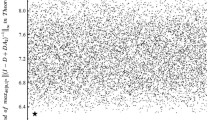Abstract
Given a square matrixM of ordern and a vectorq ∈ ℝn, the linear complementarity problem is the problem of either finding aw ∈ ℝn and az ∈ ℝn such thatw−Mz=q,w≥0,z≥0 andw T z=0 or showing that no such (w, z) exists. This problem is denoted asLCP(q, M). We say that a solution (w, z) toLCP(q, M) is degenerate if the number of positive coordinates in (w, z) is less thann. As in linear programming, degeneracy may cause cycling in an adjacent vertex following methods like Lemke's algorithm. Moreover, ifLCP(0,M) has a nontrivial solution, a condition related to degeneracy, then unless certain other conditions are satisfied, the algorithm may not be able to decide about the solvability of the givenLCP(q, M). In this paper we review the literature on the implications of degeneracy to the linear complementarity theory.
Similar content being viewed by others
References
M. Aganagic and R.W. Cottle, A note onQ-matrices, Math. Progr. 16 (1979) 374.
M.S. Bazaraa and C.M. Shetty,Nonlinear Programming — Theory and Algorithms (Wiley, New York, 1979).
R.G. Bland, New finite pivoting rules for the simplex method, Math. Oper. Res. 2 (1977) 103.
R. Chandrasekaran, A special case of the complementary pivot algorithm, Opsearch 7 (1970) 263.
Y.Y. Chang, Least index resolution of degeneracy in linear complementarity problems, Technical Report 79-14, Department of Operations Research, Stanford University (1979).
R.W. Cottle and Y.Y. Chang, Least index resolution of degeneracy in linear complementarity problems with sufficient matrices, Technical Report SOL 90-9, Systems Optimization Laboratory, Department of Operations Research, Stanford University (1990).
R.W. Cottle and G.B. Dantzig, Complementary pivot theory of mathematical programming, Lin. Alg. Appl. 1 (1968) 103.
R.W. Cottle, Solution rays for a class of complementarity problems, Math. Progr. Study 1 (1974) 59.
R.W. Cottle, CompletelyQ-matrices, Math. Progr. 19 (1980) 347.
R.W. Cottle and R.E. Stone, On the uniqueness of solutions to linear complementarity problems, Math. Progr. 27 (1983) 191.
C.W. Cryer, The method of Christopherson for solving the free boundary problems for infinite journal bearing by means of finite differences, Math. Comp. 25 (1971) 435.
R.D. Doverspike, Some perturbation results for the linear complementarity problems, Math. Progr. 23 (1982) 181.
N. Eagambaram and S.R. Mohan, On strongly degenerate complementary cones and solution rays, Math. Progr. 44 (1989) 77.
N. Eagambaram and S.R. Mohan, On some classes of linear complementarity problems with matrices of ordern and rank (n−1), Math. Oper. Res. 15 (1990) 243.
N. Eagambaram and S.R. Mohan, A note on the linear complementarity problem with anN 0-matrix, Arabian J. Sci. Eng. 16 (1991) 341.
B.C. Eaves, The linear complementarity problem, Manag. Sci. 17 (1971) 612.
C.B. Garcia, Some classes of matrices in linear complementarity theory, Math. Progr. 5 (1973) 299.
M.S. Gowda, On the continuity of the solution map of the linear complementarity problem, Research Report, 90-23, University of Maryland at Baltimore County (1990).
G. Hadley,Linear Programming (Addison-Wesley, Reading, MA, 1962).
M.W. Jeter and W.C. Pye, An example of nonregular semi-monotoneQ-matrix, Math. Progr. 44 (1989) 331
I. Kaplansky, A contribution to Von Neumann's theory of games, Ann. Math. 146 (1945) 474.
S. Karamardian, The complementarity problem, Math. Progr. 2 (1972) 107.
M. Kostreva, Cycling in linear complementarity problems, Math. Progr. 16 (1979) 127.
L.C. Larsen,Problem-Solving through Problems (Springer, 1983).
C.E. Lemke and J.T. Howson Jr., Equilibrium points of bimatrix games, SIAM J. Appl. Math. 12 (1964) 413.
C.E. Lemke, Bimatrix equilibrium points and mathematical programming, Manag. Sci. 11 (1965) 681.
G. Maier, A matrix structural theory of linear elastoplasticity with interacting yield planes, Meccanica 5 (1970) 45.
G. Maier, Problem 72-7, A parametric linear complementary problem, SIAM Rev. 14 (1972) 364.
O.L. Mangasarian, Linear complementarity problems solvable by a single linear program, Math. Progr. 10 (1976) 263.
K.J. Marshall and J.W. Suurballe, A note on cycling in the simplex method, Naval Res. Log. Quarterly 16 (1969) 121.
R.J. McElicea,The Theory of Information and Coding, Encyclopedia of Mathematics (Addison-Wesley, Reading, MA, 1973).
S.R. Mohan, T. Parthasarathy and R. Sridhar,\(\bar N\)-matrices and the classQ, Technical Report No. 9110, Indian Statistical Institute, Delhi Centre (1991).
K.G. Murty, On the number of solutions to the complementarity problem and spanning properties of complementary cones, Lin. Alg. Appl. 5 (1972) 65.
K.G. Murty,Linear Programming (Wiley, New York, 1983).
K.G. Murty,Linear Complementarity, Linear and Non-linear Programming (Heldermann, Berlin, 1988).
W.C. Pye, AlmostP 0-matrices and the classQ, Technical Report, Department of Mathematics, University of Southern Mississippi (June 1990).
R. Saigal, A characterization of the constant parity property of the number of solutions to the linear complementarity problem, SIAM J. Appl. Math. 23 (1972) 40.
R. Saigal, On the class of complementary cones and Lemke's algorithm, SIAM J. Appl. Math. 23 (1972) 41.
R. Saigal, On a special linear complementarity problem, Opsearch 8 (1971) 201.
R. Saigal and R.E. Stone, Proper, reflecting and absorbing facets of complementary cones, Math. Progr. 31 (1985) 106.
H. Samelson, R.M. Thrall and O. Wesler, A partition theorem for Euclideann-space, Proc. Amer. Math. Soc. 9 (1958) 805–807.
R.E. Stone, Linear complementarity problem with an invariant number of solutions, Math. Progr. 34 (1986) 265.
M.J. Todd, Orientation in complementary pivot algorithms, Math. Oper. Res. 1 (1976) 54.
L. Van der Heyden, A variable dimension algorithm for the linear complementarity problem, Math. Progr. 19 (1980) 328.
Author information
Authors and Affiliations
Rights and permissions
About this article
Cite this article
Mohan, S.R. Degeneracy in linear complementarity problems: a survey. Ann Oper Res 46, 179–194 (1993). https://doi.org/10.1007/BF02096262
Issue Date:
DOI: https://doi.org/10.1007/BF02096262



